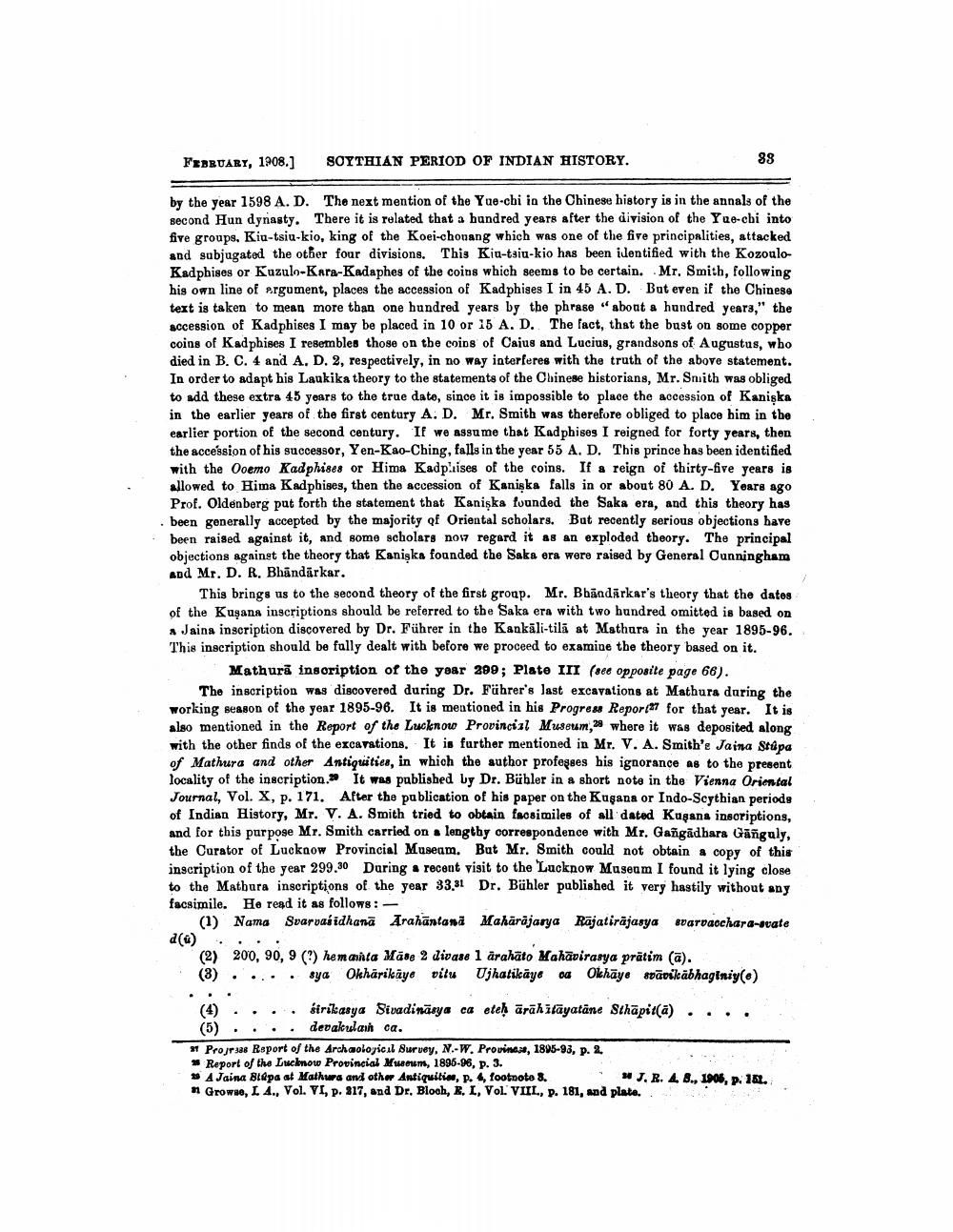________________
FEBRUARY, 1908.]
by the year 1598 A. D. The next mention of the Yue-chi in the Chinese history is in the annals of the second Hun dynasty. There it is related that a hundred years after the division of the Yue-chi into five groups, Kiu-tsiu-kio, king of the Koei-chonang which was one of the five principalities, attacked and subjugated the other four divisions. This Kiu-tsiu-kio has been identified with the KozouloKadphises or Kuzulo-Kara-Kadaphes of the coins which seems to be certain. Mr. Smith, following his own line of argument, places the accession of Kadphises I in 45 A. D. But even if the Chinese text is taken to mean more than one hundred years by the phrase "about a hundred years," the accession of Kadphises I may be placed in 10 or 15 A. D. The fact, that the bust on some copper coins of Kadphises I resembles those on the coins of Caius and Lucius, grandsons of Augustus, who died in B. C. 4 and A. D. 2, respectively, in no way interferes with the truth of the above statement. In order to adapt his Laukika theory to the statements of the Chinese historians, Mr. Smith was obliged to add these extra 45 years to the true date, since it is impossible to place the accession of Kaniska in the earlier years of the first century A. D. Mr. Smith was therefore obliged to place him in the earlier portion of the second century. If we assume that Kadphises I reigned for forty years, then the accession of his successor, Yen-Kao-Ching, falls in the year 55 A. D. This prince has been identified with the Ooemo Kadphises or Hima Kadphises of the coins. If a reign of thirty-five years is allowed to Hima Kadphises, then the accession of Kaniska falls in or about 80 A. D. Years ago Prof. Oldenberg put forth the statement that Kaniska founded the Saka era, and this theory has been generally accepted by the majority of Oriental scholars. But recently serious objections have been raised against it, and some scholars now regard it as an exploded theory. The principal objections against the theory that Kaniska founded the Saka era were raised by General Cunningham and Mr. D. R. Bhandarkar.
SOYTHIAN PERIOD OF INDIAN HISTORY.
This brings us to the second theory of the first group. Mr. Bhandarkar's theory that the dates of the Kusana inscriptions should be referred to the Saka era with two hundred omitted is based on a Jaina inscription discovered by Dr. Führer in the Kankali-tila at Mathura in the year 1895-96. This inscription should be fully dealt with before we proceed to examine the theory based on it.
Mathura inscription of the year 299; Plate III (see opposite page 66).
28
The inscription was discovered during Dr. Führer's last excavations at Mathura during the working season of the year 1895-96. It is mentioned in his Progress Report for that year. It is also mentioned in the Report of the Lucknow Provincial Museum, where it was deposited along with the other finds of the excavations. It is further mentioned in Mr. V. A. Smith'e Jaina Stúpa of Mathura and other Antiquities, in which the author professes his ignorance as to the present locality of the inscription. It was published by Dr. Bühler in a short note in the Vienna Oriental Journal, Vol. X, p. 171. After the publication of his paper on the Kugana or Indo-Scythian periods of Indian History, Mr. V. A. Smith tried to obtain facsimiles of all dated Kugana inscriptions, and for this purpose Mr. Smith carried on a lengthy correspondence with Mr. Gangadhara Ganguly, the Curator of Lucknow Provincial Museum. But Mr. Smith could not obtain a copy of this inscription of the year 299.30 During a recent visit to the Lucknow Museum I found it lying close to the Mathura inscriptions of the year 33,31 Dr. Bühler published it very hastily without any facsimile. He read it as follows:
(1) Nama Svarvasidhana Arahantana Mahārājarya Rajatiräjasya svarvacchara-svate
d(u)
(2) 200, 90, 9(?) hemamta Mase 2 divase 1 arahato Mahavirasya prātim (ā).
(3)
(4)
(5)
.
88
sya Okhārikaye vitu Ujhatikaye oa Okhaye svavikabhaginiy(e)
sirikasya Sivadinasya ca eteḥ arahitayatane Sthapit(a) devakulam ca.
1 Projr338 Report of the Archaological Survey, N.-W. Proviness, 1895-93, p. 2. Report of the Lucknow Provincial Museum, 1895-96, p. 3.
A Jaina Blupa at Mathura and other Antiquities, p. 4, footnote 8.
n Growse, L. A., Vol. VI, p. 317, and Dr. Bloch, E, L, Vol. VIII, p. 181, and plate.
2 J. R. A. 8., 1906, p. 15L..




